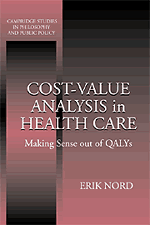Book contents
- Frontmatter
- Contents
- List of Tables and Figures
- Preface and Acknowledgments
- Overview
- Reader's Guide
- 1 Maximizing Value in Health Care
- 2 Three Basic Issues in Economic Evaluation
- 3 QALYs
- 4 Concerns for Fairness
- 5 The Limitations of Utility Measurement
- 6 Ways to Go
- Annex: An Example of Cost-Value Analysis
- References
- Index
5 - The Limitations of Utility Measurement
Published online by Cambridge University Press: 06 July 2010
- Frontmatter
- Contents
- List of Tables and Figures
- Preface and Acknowledgments
- Overview
- Reader's Guide
- 1 Maximizing Value in Health Care
- 2 Three Basic Issues in Economic Evaluation
- 3 QALYs
- 4 Concerns for Fairness
- 5 The Limitations of Utility Measurement
- 6 Ways to Go
- Annex: An Example of Cost-Value Analysis
- References
- Index
Summary
There are a highly worrisome subjectivity and diversity in the ways in which the QALY gains of different interventions are calculated in applied health economics. For instance, in a review of fifteen published studies, I found that twenty-four out of thirty-six valuations of health states were based simply on the various author's own rough judgments of what seemed to be “reasonable” or “plausible” values. Seven were taken from previous publications. In one of these seven cases, no reference was given. In another, the valuation could not be found in the reference that was given. In two cases, the value in the previous publications was based on its author's own judgment. In the remaining three cases, the values turned out to be based on a scale that does not purport to be a utility scale (Nord 1993c). Gerard (1992) and Salkeld et al. (1995) report similar findings.
A reason for this unsatisfactory situation seems to be a considerable lack of consensus in the scientific community as to what exactly QALYs are supposed to count (Richardson 1994). There is of course an agreement in general terms, as reflected in the elementary explanation given in Chapter 3. But a genuinely curious person who wonders exactly what utility numbers and QALYs correspond to in the real world is likely to get many different answers.
In the following I shall discuss the meaning and the measurement of utilities in considerable detail. There are many thorny issues here. I concentrate on the following:
Are utilities meant to be ex ante or ex post?
Whom should one ask about the utility of health states?
How should one ask?
[…]
- Type
- Chapter
- Information
- Cost-Value Analysis in Health CareMaking Sense out of QALYS, pp. 79 - 112Publisher: Cambridge University PressPrint publication year: 1999



